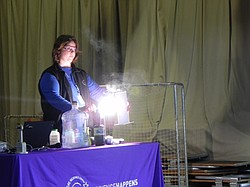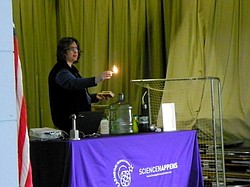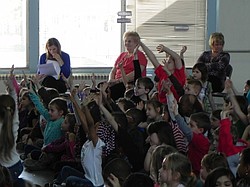Science center sparks interest at Watson
In the 1800’s, the flash of camera bulbs was provided by the burning of magnesium, which produces a bright white light. Gawlas burned a strip of magnesium to show the students how bright the chemical burns.
After showing the students the chemical reaction between strontium and fire, Gawlas showed the crowd the green explosion when copper meets fire. The scientist tested the student’s patience by holding the match above the bottle as long as she could.
Gawlas’ approach had the Watson students very excited to answer questions and learn more about science.
By SARAH FOOR
Mindy Gawlas, a staff educator for the Carnegie Science Center’s “Science on the Road” Program, only brought a few different items to Watson Elementary for her presentation on light and color on March 14.
The students soon found out, however, that when she combined her items, amazing chemical reactions began to happen.
Gawlas said she enjoys teaching advanced scientific processes in an approachable way.
“I’m talking to first- and second-graders today, and teaching them about ideas like wavelengths, tone, light and the chemical reactions that make different colors. It’s advanced stuff, but I think science can be learned at any age. I’m asking lots of questions, demonstrating and making this a vivid process.”
The presentation explored color through a Jeopardy-style question game. Gawlas taught short lessons between questions, teaching the students about scientific processes with hands-on demonstrations.
Gawlas explained how certain chemicals react with fire — strontium and copper are used in fireworks, because their chemical reactions create red and green light, respectively. In a safe process, she showed students the colorful explosions in a large plastic bottle.
The scientist also told the children that magnesium was used in old-fashioned flashbulb photography because it emits a bright white light. She burned a strip of magnesium for the students, but shielded the students’ eyes from too much of the blinding light.
“It’s an informal science event, but I really hope it helps spark an interest in science for life,” Gawlas shared after her presentation.
“This event is about motivating the kids in science in preparation for our Arts and Science Fair,” explained Arts and Science event chair Carolyn Senedak.
“We’ve invited Carnegie here before our fair for about 10 years now. Presenters like Ms. Gawlas remind us why — they do a really wonderful job,” added Senedak.
 43
43



